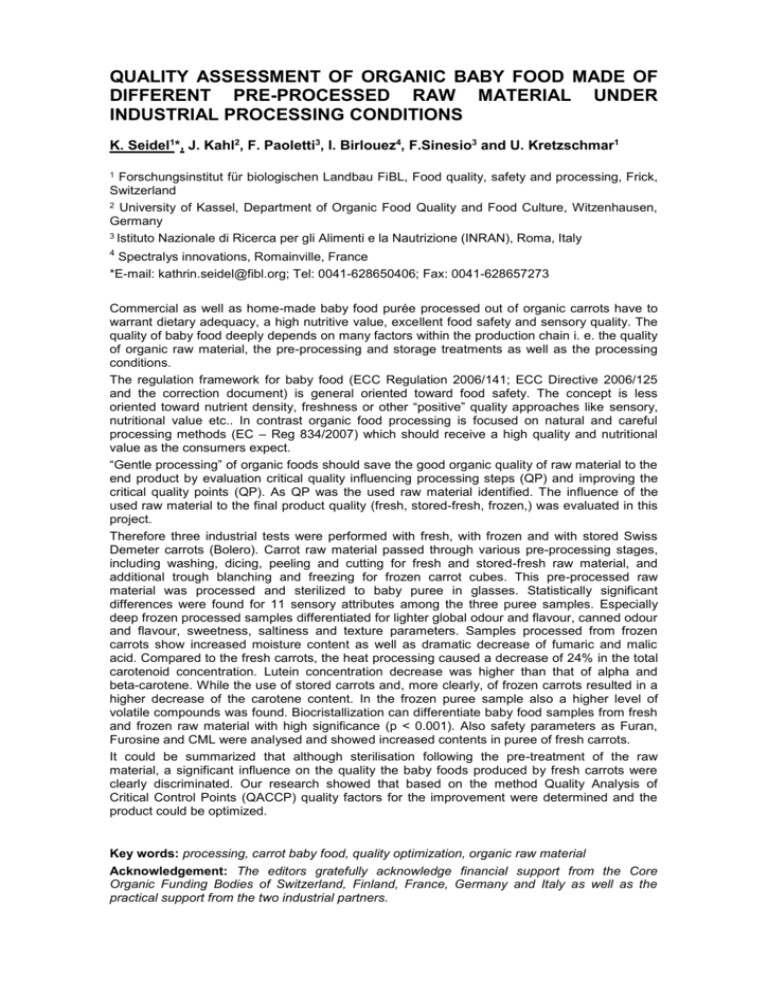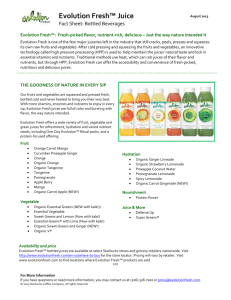OIL AND PROTEIN CONTENT OF APRICOT KERNEL GROWN IN
advertisement

QUALITY ASSESSMENT OF ORGANIC BABY FOOD MADE OF DIFFERENT PRE-PROCESSED RAW MATERIAL UNDER INDUSTRIAL PROCESSING CONDITIONS K. Seidel1*, J. Kahl2, F. Paoletti3, I. Birlouez4, F.Sinesio3 and U. Kretzschmar1 1 Forschungsinstitut für biologischen Landbau FiBL, Food quality, safety and processing, Frick, Switzerland 2 University of Kassel, Department of Organic Food Quality and Food Culture, Witzenhausen, Germany 3 Istituto Nazionale di Ricerca per gli Alimenti e la Nautrizione (INRAN), Roma, Italy 4 Spectralys innovations, Romainville, France *E-mail: kathrin.seidel@fibl.org; Tel: 0041-628650406; Fax: 0041-628657273 Commercial as well as home-made baby food purée processed out of organic carrots have to warrant dietary adequacy, a high nutritive value, excellent food safety and sensory quality. The quality of baby food deeply depends on many factors within the production chain i. e. the quality of organic raw material, the pre-processing and storage treatments as well as the processing conditions. The regulation framework for baby food (ECC Regulation 2006/141; ECC Directive 2006/125 and the correction document) is general oriented toward food safety. The concept is less oriented toward nutrient density, freshness or other “positive” quality approaches like sensory, nutritional value etc.. In contrast organic food processing is focused on natural and careful processing methods (EC – Reg 834/2007) which should receive a high quality and nutritional value as the consumers expect. “Gentle processing” of organic foods should save the good organic quality of raw material to the end product by evaluation critical quality influencing processing steps (QP) and improving the critical quality points (QP). As QP was the used raw material identified. The influence of the used raw material to the final product quality (fresh, stored-fresh, frozen,) was evaluated in this project. Therefore three industrial tests were performed with fresh, with frozen and with stored Swiss Demeter carrots (Bolero). Carrot raw material passed through various pre-processing stages, including washing, dicing, peeling and cutting for fresh and stored-fresh raw material, and additional trough blanching and freezing for frozen carrot cubes. This pre-processed raw material was processed and sterilized to baby puree in glasses. Statistically significant differences were found for 11 sensory attributes among the three puree samples. Especially deep frozen processed samples differentiated for lighter global odour and flavour, canned odour and flavour, sweetness, saltiness and texture parameters. Samples processed from frozen carrots show increased moisture content as well as dramatic decrease of fumaric and malic acid. Compared to the fresh carrots, the heat processing caused a decrease of 24% in the total carotenoid concentration. Lutein concentration decrease was higher than that of alpha and beta-carotene. While the use of stored carrots and, more clearly, of frozen carrots resulted in a higher decrease of the carotene content. In the frozen puree sample also a higher level of volatile compounds was found. Biocristallization can differentiate baby food samples from fresh and frozen raw material with high significance (p < 0.001). Also safety parameters as Furan, Furosine and CML were analysed and showed increased contents in puree of fresh carrots. It could be summarized that although sterilisation following the pre-treatment of the raw material, a significant influence on the quality the baby foods produced by fresh carrots were clearly discriminated. Our research showed that based on the method Quality Analysis of Critical Control Points (QACCP) quality factors for the improvement were determined and the product could be optimized. Key words: processing, carrot baby food, quality optimization, organic raw material Acknowledgement: The editors gratefully acknowledge financial support from the Core Organic Funding Bodies of Switzerland, Finland, France, Germany and Italy as well as the practical support from the two industrial partners.







